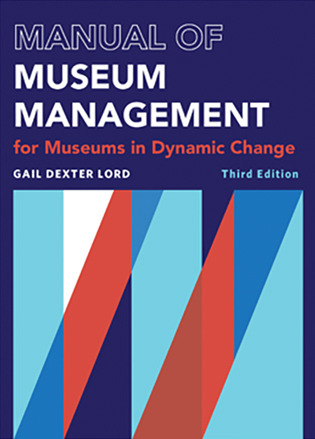Manual of Museum Management - Third Edition

This is a book for museum leaders, managers, trustees and staff, and all those who care about museums and are curious about how they work.
This new edition of the classic Manual that first appeared in 1997 is an exciting guide to managing museums in a time of sweeping changes. Renowned museum planner Gail Dexter Lord applies her international museum experience to create this comprehensive and detailed guide to the tools and strategies to successfully address today’s issues and opportunities, including climate change and social justice, repatriation, teamwork, technological innovations, community connections and building on the huge reservoir of public trust in museums.
With new case studies by 30 creative museum leaders from across the globe (half of whom are BIPOC), the Manual demonstrates the innovation and resilience of the museum sector today working toward multiple perspectives in learning, content and exhibitions and a non- colonial philosophy of management, creating a more human museum experience of caring empathy and equity for staff and visitors.
Key Features
- Tackles challenging issues like racial and social justice, climate crisis, repatriation, colonialism, unionization, working conditions and governance controversies.
- Shares an incisive analysis of sweeping changes in the museum sector.
- Presents practical hands-on advice on writing collection policy, security plans and budget process.
- Contains a detailed Glossary specific to current museum management terms.
- Offers a selection of mission, mandate vision and values statements from leading museums that can help museums write their own.
Q&A WITH GAIL
WHO IS THIS BOOK FOR?
This is a book for museum leaders, managers, trustees and staff, and all those who care about museums and are curious about how they work. I touch on so many aspects of our work — like exhibitions, strategy, communications and technology. Museums are stable institutions, with enormous amounts of public trust, and museum staff are resilient. At Lord, we provide support and advice to museums and cultural organizations, and now they can now find it within these pages as well.
HOW IS THIS EDITION DIFFERENT?
Racial and social justice feature much more prominently, as does the climate crisis, and the need for clear values. Repatriation was previously referenced as a technical issue, not as a moral/ethical issue. Colonialism is very much in this book. There are also case studies on unionization, working conditions and governance controversies. And this edition really introduces the concept of teams in a huge way. Teamwork is the essence of museum management in our time.
WHAT ARE YOU MOST PROUD OF?
MMM3 features 30 case studies by diverse leaders from around the world, half of whom are BIPOC. This is a first, and a tremendous aspect of this book. Diverse viewpoints by people who are diverse is part of our philosophy at Lord. I love that this edition is bookended by two incredible contributions: John G. Hampton’s incredibly thoughtful and sensitive piece on “Decolonizing Museum Management” and Sandra Jackson-Dumont’s “How Museums can Matter More,” which is an amazing contribution that is beautifully written and so inspiring. I’m also so proud of the contributions made by our remarkable Lord team, who are so extraordinary at what they do.
WHAT CAN PEOPLE LEARN?
This book is designed to be very, very handy. We have so many clients who we help with collection policies, security plans, budget processes. We took all that great content out of the main body of the book and put it in the appendices, so the book can focus on storytelling, and the technical pieces live in their own section. A lot of that excellent content was written by my late husband Barry. And I love the Glossary, too. It’s very comprehensive and up-to-date. Lots of people ask, what's the difference between a feasibility study and a master plan? This will be so useful for them.
WHAT WILL PEOPLE TAKE AWAY?
A feeling of empowerment. We know we can’t create change overnight. We make change through good management, good professional practice, ethics and values.

